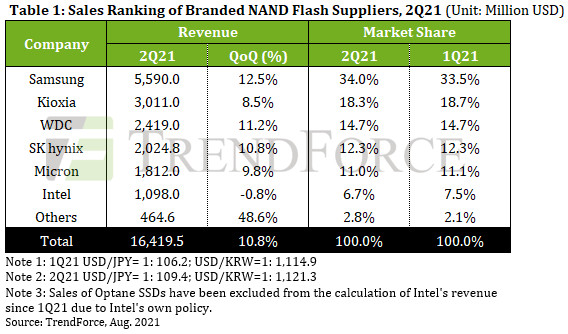Strong Notebook and Data Center Demand Drive NAND Flash Revenue With 10% Growth
Data centers will become the main driver
NAND Flash is one of the most critical and sought-after types of the semiconductor chip. It is powering systems across the globe and enables everyone to store their data with great speeds and capacity. Today, we are witnessing a report from TrendForce that analyzes the second-quarter revenue of NAND Flash makers, showing the increasing demand coming from notebook and data center markets.
According to TrendForce, the demand for NAND Flash was very high, resulting in a 10.8% overall growth in the second quarter of this year, compared to the previous first quarter of 2021. As the report suggests, the demand was primarily driven by two main factors: notebooks and data centers.
In the notebook side of the story, we have witnessed an increased demand, despite the shortage of controller ICs used in their manufacturing. Manufacturers have been embedding a lot of NAND Flash into their products, resulting in increased capacities over time and more use of NAND Flash memory.
For data center applications, the adoption of 4TB and 8TB enterprise SSDs has resulted in almost record-setting amounts of NAND Flash used in data centers. As enterprise users continue to adopt higher-capacity SSDs in their builds, the NAND Flash market is expected to continue this upwards trajectory in the coming months.

In the table above, you can see the revenue and market share of various NAND Flash suppliers including Micron, SK Hynix, Samsung, Western Digital (WDC), Kioxia, and Intel. Almost all these suppliers have increased their NAND Flash business revenue, except Intel, which experienced a slight decline of 0.8% quarter-over-quarter.
Nevertheless, the market outlook for Q3 and the period after it looks promising for the notebook segment, and especially data centers, and the upcoming launch of Intel and AMD server processors drives a huge amount of adoption of new processors, resulting in the increased demand for accompanying storage solutions like enterprise SSDs.
Get Tom's Hardware's best news and in-depth reviews, straight to your inbox.